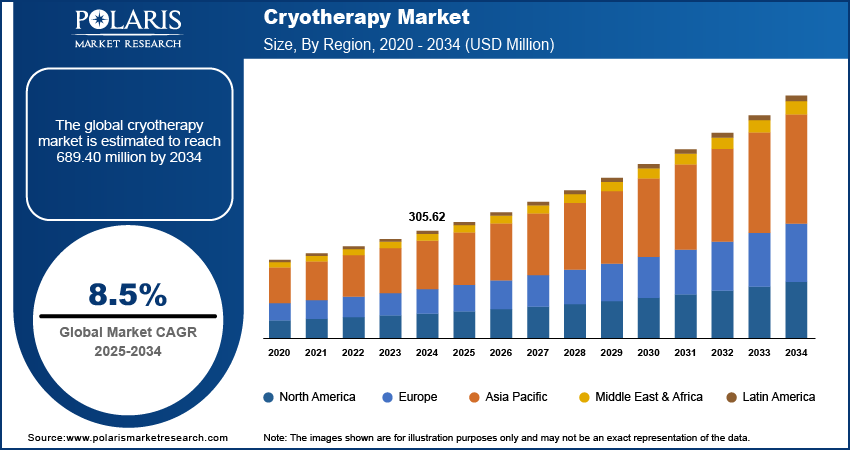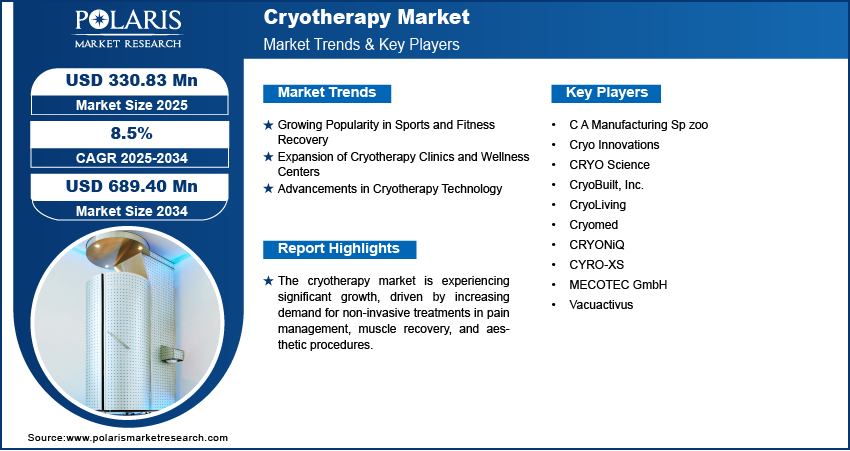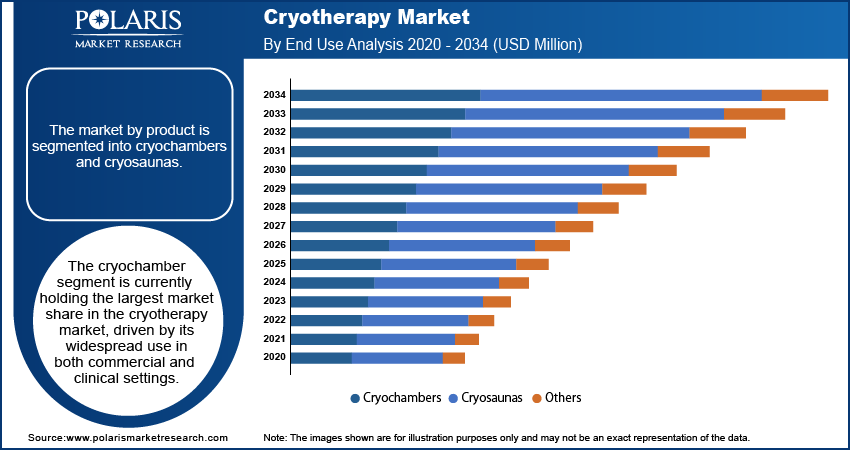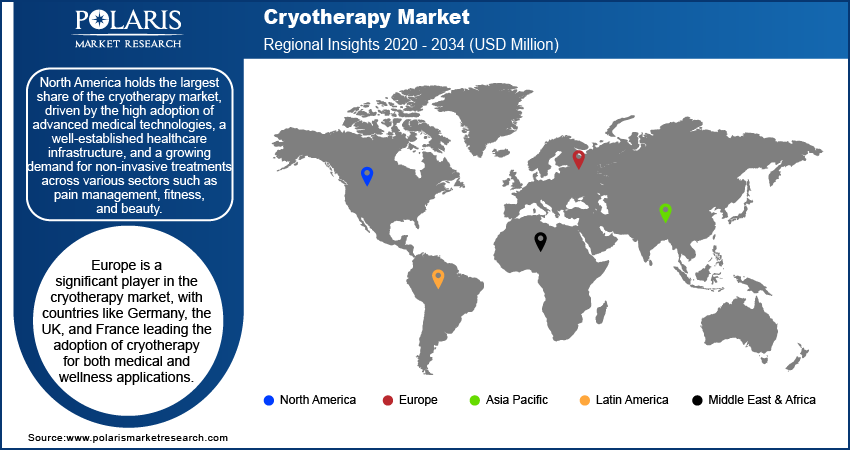
Cryotherapy Market Size, Share, Trends, Industry Analysis Report: By Product (Cryochambers, Cryosaunas, and Others), Application, End User, and Region (North America, Europe, Asia Pacific, Latin America, and Middle East & Africa) – Market Forecast, 2025–2034
- Published Date:Mar-2025
- Pages: 119
- Format: PDF
- Report ID: PM1533
- Base Year: 2024
- Historical Data: 2020-2023
Cryotherapy Market Overview
The global cryotherapy market size was valued at USD 305.62 million in 2024. The market is projected to grow from USD 330.83 million in 2025 to USD 689.40 million by 2034, exhibiting a CAGR of 8.5% from 2025 to 2034.
The cryotherapy market refers to the use of cold temperatures for therapeutic purposes, commonly employed in the treatment of muscle injuries, pain management, and skin conditions, as well as in aesthetic procedures. It includes a range of treatments, such as whole-body cryotherapy, localized cryotherapy, and cryosurgery.
The increasing demand for non-invasive pain management treatments, rising awareness about the benefits of cryotherapy, and advancements in cryotherapy technology are driving market growth. Additionally, the growing popularity of cryotherapy among athletes and fitness enthusiasts for recovery purposes is contributing to the cryotherapy market expansion. Trends indicate a rising adoption of cryotherapy clinics and wellness centers, as well as increased use in dermatological treatments for anti-aging and skin rejuvenation.

To Understand More About this Research: Request a Free Sample Report
Cryotherapy Market Dynamics
Growing Popularity in Sports and Fitness Recovery
Cryotherapy's popularity in the sports and fitness industries is rapidly increasing due to its superficial benefits in muscle recovery and injury prevention. Athletes use cryotherapy to reduce muscle soreness, improve performance, and enhance recovery times after intense physical exertion. The use of cryotherapy has expanded beyond professional sports to include fitness enthusiasts and everyday gym-goers. According to a 2020 study published in the Journal of Athletic Training, cryotherapy can significantly reduce delayed-onset muscle soreness (DOMS) after exercise. As athletes and trainers increasingly endorse cryotherapy for recovery, the demand for specialized cryotherapy equipment and services in fitness centers and rehabilitation clinics is growing.
Expansion of Cryotherapy Clinics and Wellness Centers
A notable cryotherapy market trend is the expansion of cryotherapy clinics and wellness centers offering a variety of services, including whole-body cryotherapy, localized cryotherapy, and cryoskin treatments for aesthetics. As consumers seek non-invasive methods for improving health, pain management, and skin rejuvenation, cryotherapy has gained traction in the wellness industry. According to the National Institutes of Health (NIH), the growing trend in wellness treatments is creating a market for innovative cryotherapy applications, especially in anti-aging and skin care, leading to a surge in new clinic openings. This demand has contributed to the surge in the number of cryotherapy centers, with several chains opening in the major US cities.
Advancements in Cryotherapy Technology
Technological advancements are driving the adoption of cryotherapy treatments in both clinical and personal use settings. Innovations in cryotherapy equipment, such as improved cooling systems and enhanced safety features, have made treatments more efficient, accessible, and comfortable. Newer cryotherapy devices allow for better temperature regulation and faster treatment times, addressing previous concerns regarding safety and effectiveness. For example, some newer machines are designed to deliver targeted cooling to specific parts of the body, making treatments more precise and efficient. The increasing availability of portable cryotherapy devices is also contributing to the market's expansion, allowing consumers to perform treatments at home. This technological progression is expected to further fuel the cryotherapy market growth.

Cryotherapy Market Segment Insights
Cryotherapy Market Assessment by Product
The cryotherapy market, by product, is segmented into cryochambers, cryosaunas, and others. The cryosauna segment holds the largest cryotherapy market share. Cryosaunas are single-person units that focus on localized cryotherapy, offering a more targeted treatment. The segment’s growth is attributed to the increasing interest in personalized, non-invasive treatments for specific areas of the body. As consumers seek alternatives for aesthetic and recovery purposes, cryosaunas are gaining popularity due to their convenience, lower cost compared to cryochambers, and ease of use in both clinical and home settings. Furthermore, advancements in cryosauna technology, such as improved insulation and faster cooling times, are contributing to their growing adoption, making them an attractive option for individuals seeking quick and efficient cryotherapy treatments.
The cryochamber segment, while smaller, is experiencing the fastest growth rate in the market, driven by its widespread use in both commercial and clinical settings. Cryochambers are large, enclosed units that expose the entire body to extremely cold temperatures, typically reaching -100°C to -140°C. These chambers are preferred for whole-body cryotherapy due to their ability to treat multiple individuals simultaneously, making them ideal for wellness centers and sports recovery facilities. The increasing adoption of cryochambers by professional athletes and fitness centers is contributing to their dominant position in the market. Additionally, their ability to treat various conditions, such as muscle recovery, pain management, and even certain skin conditions, is further fueling their demand.
Cryotherapy Market Evaluation by Application
The cryotherapy market, by application, is segmented into pain management, beauty & wellness, fitness, and others. The pain management segment holds the largest cryotherapy market share due to the widespread use of cryotherapy for treating chronic pain conditions, muscle injuries, and inflammation. Cryotherapy has proven effective in reducing pain and promoting healing, particularly for individuals suffering from conditions such as arthritis, fibromyalgia, and sports-related injuries. As a result, hospitals, pain management clinics, and rehabilitation centers increasingly offer cryotherapy as a non-invasive, alternative treatment. The growing preference for non-pharmaceutical pain relief methods has significantly contributed to the expansion of this segment.
The beauty & wellness segment is also experiencing the fastest growth rate, driven by rising consumer demand for non-invasive aesthetic treatments and skin rejuvenation procedures. Cryotherapy is becoming popular in beauty salons and wellness centers for its ability to improve skin tone, reduce wrinkles, and promote collagen production. The demand for cryotherapy treatments that target specific skin concerns, such as cryofacials, has gained traction, particularly in the anti-aging market. Additionally, the rise of cryotherapy as a popular wellness treatment for overall rejuvenation is fueling its growth in the beauty and wellness industry. These trends indicate a strong potential for continued expansion in this segment as consumers increasingly seek innovative and effective skincare solutions.
Cryotherapy Market Assessment by End User
The cryotherapy market segmentation, based on end user, includes cryotherapy centers, spas & fitness centers, and others. The cryotherapy centers segment holds the largest market share, as these facilities are primarily dedicated to providing a wide range of cryotherapy treatments. These centers cater to individuals seeking specialized therapies for pain management, muscle recovery, and skin rejuvenation. As the demand for advanced, targeted treatments increases, cryotherapy centers have become a central hub for both medical and wellness-related cryotherapy services. Their focus on professional-grade equipment, along with a range of therapeutic options, positions them as the preferred choice for consumers seeking a comprehensive cryotherapy experience. The continued growth of such centers is expected as more individuals turn to cryotherapy for its health benefits and effective treatments.
The spas & fitness centers segment is also witnessing the fastest growth in the market. As the wellness and fitness industries continue to expand, the integration of cryotherapy into these settings has gained traction, particularly for muscle recovery and overall wellness. Fitness centers and spas are increasingly adopting cryotherapy treatments to attract customers looking for innovative recovery solutions. The rising trend of personalized health and fitness, combined with the affordability and convenience of receiving cryotherapy in these locations, has led to rapid growth in this segment. These facilities also cater to individuals seeking non-medical cryotherapy options, such as aesthetic treatments, which further boosts their market potential.

Cryotherapy Market Regional Insights
By region, the study provides the cryotherapy market insights into North America, Europe, Asia Pacific, Latin America, and the Middle East & Africa. North America holds the largest market share, driven by the high adoption of advanced medical technologies, a well-established healthcare infrastructure, and a growing demand for non-invasive treatments across various sectors such as pain management, fitness, and beauty. The US, in particular, has emerged as a key hub for cryotherapy centers, sports rehabilitation facilities, and wellness clinics, with increasing consumer awareness and acceptance of cryotherapy’s benefits. The region's market growth is also supported by the presence of major cryotherapy equipment manufacturers, continuous advancements in technology, and the widespread use of cryotherapy among athletes and fitness enthusiasts. These factors, coupled with a high level of disposable income, contribute to North America's dominant position in the global market.
Europe is a significant player in the cryotherapy market, with countries such as Germany, the UK, and France leading the adoption of cryotherapy for both medical and wellness applications. The market is driven by an increasing number of cryotherapy centers and the growing popularity of non-invasive treatments in aesthetics and pain management. Europe’s well-developed healthcare systems, combined with a rising focus on wellness and fitness, are contributing to the demand for cryotherapy. The region’s robust healthcare regulations and increasing interest in alternative therapies also support the growth of cryotherapy services. In addition, the market benefits from the rising trend of cryotherapy for athletic recovery and skin treatments, particularly in countries with a high density of sports professionals and wellness enthusiasts.
The Asia Pacific cryotherapy market is witnessing rapid growth, primarily driven by rising disposable incomes, an increasing focus on health and wellness, and growing awareness of the benefits of cryotherapy. Countries such as Japan, China, and Australia are leading the adoption of cryotherapy, with the latter particularly seeing a rise in wellness centers integrating cryotherapy for recovery and anti-aging treatments. As the fitness industry expands in the region, demand for cryotherapy in sports recovery is also increasing. Additionally, the growing interest in non-invasive aesthetic procedures and anti-aging treatments is further driving the adoption of cryotherapy in beauty salons and spas. The market is expected to continue growing as more consumers turn to cryotherapy for its purported health and cosmetic benefits.

Cryotherapy Market – Key Market Players and Competitive Insights
Key players in the cryotherapy market include C A Manufacturing Sp zoo; Cryo Innovations; CRYO Science; CryoBuilt, Inc.; CryoLiving; Cryomed; CRYONiQ; CYRO-XS; MECOTEC GmbH; and Vacuactivus. These companies are actively involved in developing and supplying cryotherapy equipment and services for both commercial and personal use. Many of these players offer various types of cryotherapy machines, including cryochambers and cryosaunas, as well as associated services, including training and equipment maintenance.
In terms of competitive dynamics, companies in the cryotherapy market are differentiating themselves by innovation in product design and increasing the accessibility of treatments through technological advancements. For instance, the development of more energy-efficient and cost-effective cryotherapy units has allowed companies to target a broader consumer base, including small clinics and wellness centers. The availability of portable devices, such as cryosaunas, has made cryotherapy more accessible to home users and smaller businesses. Additionally, some companies are leveraging partnerships with fitness centers and sports rehabilitation clinics to expand their market presence, capitalizing on the growing popularity of cryotherapy in sports and fitness recovery.
Market competition also hinges on the quality and safety of cryotherapy equipment. Key players are working to ensure their products are compliant with health and safety standards, addressing consumer concerns regarding safety and efficacy. As demand for cryotherapy in wellness and fitness continues to rise, players in the market are also investing in expanding their service offerings, including the establishment of cryotherapy centers and providing targeted marketing strategies to educate consumers on the benefits of cryotherapy. This combination of technological advancement and targeted market expansion is expected to intensify competition within the market.
Cryo Innovations is engaged in the design and manufacture of advanced cryotherapy chambers for wellness and recovery applications. The company specializes in developing technologically advanced cryotherapy systems, including the XR Thermal Edition Chamber. Its product portfolio features innovative solutions such as biometric safety features, thermal imaging, and live skin temperature mapping for optimized results. Cryo Innovations also provides integrated business tools like fingerprint authorization, digital waiver storage, and marketing support to streamline operations for its clients. The company has a strong presence across the United States and serves industries such as sports, fitness, and healthcare. In the cryotherapy market, Cryo Innovations focuses on enhancing safety and efficiency through advanced technology, making its systems suitable for both whole-body and localized applications.
CryoBuilt is engaged in the production of electric whole-body cryotherapy systems designed for wellness and recovery purposes. CryoBuilt specializes in low-temperature manufacturing and refrigeration technology. Its product portfolio includes electric cryotherapy chambers built entirely in-house at its California facility. The company also offers comprehensive support services through a nationwide network of technicians and remote monitoring systems. CryoBuilt serves industries ranging from biomedical to fitness centers across the United States. In the cryotherapy market, CryoBuilt emphasizes electric systems that eliminate the need for liquid nitrogen, providing a safer and more sustainable alternative for whole-body cryotherapy treatments.
List of Key Companies in Cryotherapy Market
- C A Manufacturing Sp zoo
- Cryo Innovations
- CRYO Science
- CryoBuilt, Inc.
- CryoLiving
- Cryomed
- CRYONiQ
- CYRO-XS
- MECOTEC GmbH
- Vacuactivus
Cryotherapy Industry Developments
- October 2024: Impact Cryotherapy announced the launch of a new line of mobile cryotherapy units. The units aim to increase the accessibility to more people and businesses, particularly in remote or smaller locations.
- September 2024: Zimmer MedizinSysteme unveiled an upgraded version of its cryotherapy equipment with enhanced safety features and more precise temperature controls. This reflects its ongoing commitment to improving the user experience and meeting clinical needs.
Cryotherapy Market Segmentation
By Product Outlook
- Cryochambers
- Cryosaunas
- Others
By Application Outlook
- Pain Management
- Beauty & Wellness
- Fitness
- Others
By End User Outlook
- Cryotherapy Centers
- Spas & Fitness Centers
- Others
By Regional Outlook
- North America
- US
- Canada
- Europe
- Germany
- France
- UK
- Italy
- Spain
- Netherlands
- Russia
- Rest of Europe
- Asia Pacific
- China
- Japan
- India
- Malaysia
- South Korea
- Indonesia
- Australia
- Vietnam
- Rest of Asia Pacific
- Middle East & Africa
- Saudi Arabia
- UAE
- Israel
- South Africa
- Rest of Middle East & Africa
- Latin America
- Mexico
- Brazil
- Argentina
- Rest of Latin America
Cryotherapy Market Report Scope
|
Report Attributes |
Details |
|
Market Size Value in 2024 |
USD 305.62 million |
|
Market Size Value in 2025 |
USD 330.83 million |
|
Revenue Forecast by 2034 |
USD 689.40 million |
|
CAGR |
8.5% from 2025 to 2034 |
|
Base Year |
2024 |
|
Historical Data |
2020–2023 |
|
Forecast Period |
2025–2034 |
|
Quantitative Units |
Revenue in USD million and CAGR from 2025 to 2034 |
|
Report Coverage |
Revenue Forecast, Market Competitive Landscape, Growth Factors, and Industry Trends |
|
Segments Covered |
|
|
Regional Scope |
|
|
Competitive Landscape |
|
|
Report Format |
|
|
Customization |
Report customization as per your requirements with respect to countries, regions, and segmentation. |
How is the report valuable for an organization?
Workflow/Innovation Strategy
The cryotherapy market has been segmented into detailed segments of product, application, and end user. Moreover, the study provides the reader with a detailed understanding of the different segments at both the global and regional levels.
Growth/Marketing Strategy
The growth strategy in the cryotherapy market is focused on expanding product offerings, increasing awareness, and broadening distribution channels. Companies are investing in innovation to improve the safety, efficiency, and user experience of cryotherapy equipment, making treatments more accessible to a wider audience. Partnerships with fitness centers, wellness clinics, and sports rehabilitation facilities are key to market expansion. Additionally, many players are utilizing digital marketing and social media platforms to educate consumers on the benefits of cryotherapy, driving demand in both clinical and home-use segments. This approach is supported by the growing interest in non-invasive wellness treatments and sports recovery solutions.
FAQ's
The cryotherapy market size was valued at USD 305.62 million in 2024 and is projected to grow to USD 689.40 million by 2034.
The market is projected to register a CAGR of 8.5% during the forecast period, 2025-2034.
North America had the largest share of the market.
A few of the players in the cryotherapy market include C A Manufacturing Sp zoo; Cryo Innovations; CRYO Science; CryoBuilt, Inc.; CryoLiving; Cryomed; CRYONiQ; CYRO-XS; MECOTEC GmbH; and Vacuactivus
The cryosauna segment held the largest cryotherapy market share in 2024.
The pain management segment accounted for the largest share of the market.
Cryotherapy is a treatment that involves the use of extreme cold to manage pain, reduce inflammation, and promote healing. It can be administered through various methods, including whole-body cryotherapy (where the entire body is exposed to cold temperatures in a cryochamber or cryosauna) and localized cryotherapy (which targets specific areas of the body). The cold temperature causes blood vessels to constrict, reducing swelling and inflammation, and when the body warms up again, it increases blood flow, aiding in the healing process. Cryotherapy is used for a variety of purposes, including pain management, muscle recovery, skin treatments, and overall wellness.
A few key trends in the cryotherapy market are described below: Increasing Adoption in Sports and Fitness: Athletes and fitness enthusiasts are increasingly using cryotherapy for muscle recovery, pain relief, and injury prevention. Growth of Cryotherapy in Beauty and Wellness: Cryotherapy is gaining popularity in spas and wellness centers for aesthetic treatments, such as anti-aging and skin rejuvenation. Technological Advancements: Innovations in cryotherapy equipment, such as improved cooling systems, safety features, and portable devices, are making treatments more efficient and accessible. Expansion of Cryotherapy Clinics: More cryotherapy centers are opening globally, offering a variety of services tailored to pain management, recovery, and wellness. Increasing Adoption in Sports and Fitness: Athletes and fitness enthusiasts are increasingly using cryotherapy for muscle recovery, pain relief, and injury prevention. Growth of Cryotherapy in Beauty and Wellness: Cryotherapy is gaining popularity in spas and wellness centers for aesthetic treatments, such as anti-aging and skin rejuvenation. Technological Advancements: Innovations in cryotherapy equipment, such as improved cooling systems, safety features, and portable devices, are making treatments more efficient and accessible. Expansion of Cryotherapy Clinics: More cryotherapy centers are opening globally, offering a variety of services tailored to pain management, recovery, and wellness.
A new company entering the cryotherapy market could focus on innovation, particularly by developing more affordable, portable, and user-friendly cryotherapy devices for home use. Offering advanced features like precise temperature controls, enhanced safety measures, and faster treatment times could differentiate the company from competitors. Additionally, targeting niche markets such as personalized recovery solutions for athletes or specialized treatments for skin care and wellness could create a unique value proposition. Building partnerships with fitness centers, wellness clinics, and rehabilitation facilities for service offerings while also utilizing digital marketing to raise awareness could help the company establish a strong presence in the competitive landscape.
Companies offering cryotherapy and related solutions, and other consulting firms must buy the report.
